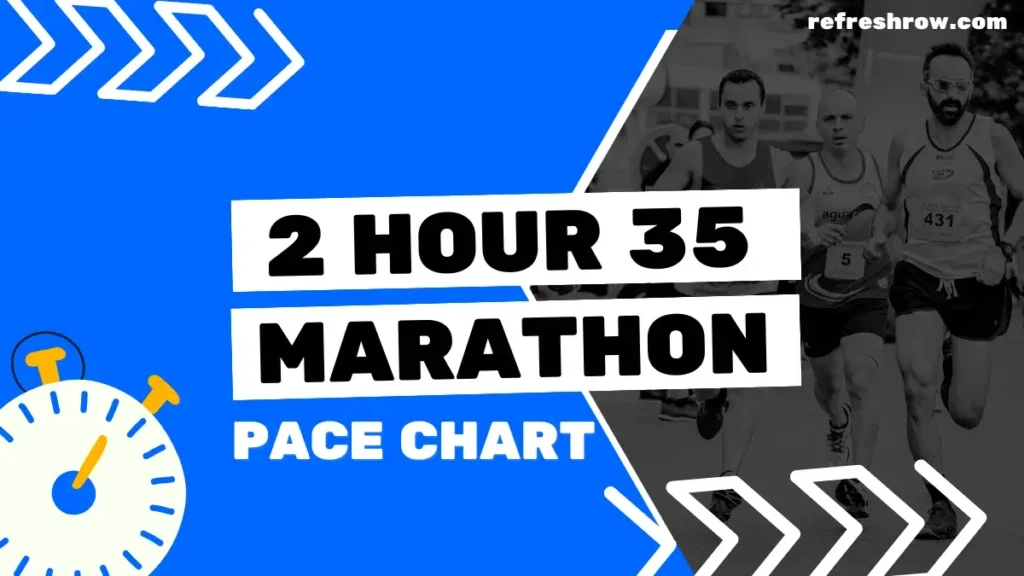To run a 3:50 hour marathon you need to run at a pace of 8:46 per mile or 5:27 per kilometer.
Following the splits below (and shaving off a second), you’ll run a sub 3:50 marathon.
I’d recommend aiming to run 1-2 minutes ahead of the split target time from 10 miles, as you’ll likely come up against crowding on race day.
3:50 Marathon Pace in Miles
| Mile | Split |
|---|---|
| 1 | 8:46 |
| 2 | 17:33 |
| 3 | 26:19 |
| 4 | 35:05 |
| 5 | 43:52 |
| 6 | 52:38 |
| 7 | 1:01:24 |
| 8 | 1:10:11 |
| 9 | 1:18:57 |
| 10 | 1:27:43 |
| 11 | 1:36:30 |
| 12 | 1:45:16 |
| 13 | 1:54:02 |
| 14 | 2:02:49 |
| 15 | 2:11:35 |
| 16 | 2:20:21 |
| 17 | 2:29:08 |
| 18 | 2:37:54 |
| 19 | 2:46:40 |
| 20 | 2:55:27 |
| 21 | 3:04:13 |
| 22 | 3:12:59 |
| 23 | 3:21:46 |
| 24 | 3:30:32 |
| 25 | 3:39:19 |
| 26 | 3:48:05 |
| 26.2 | 3:50:00 |
Download
3:50 Marathon Pace in KM
| KM | Split |
|---|---|
| 1 | 5:27 |
| 2 | 10:54 |
| 3 | 16:21 |
| 4 | 21:48 |
| 5 | 27:15 |
| 6 | 32:42 |
| 7 | 38:09 |
| 8 | 43:36 |
| 9 | 49:03 |
| 10 | 54:31 |
| 11 | 59:58 |
| 12 | 1:05:25 |
| 13 | 1:10:52 |
| 14 | 1:16:19 |
| 15 | 1:21:46 |
| 16 | 1:27:13 |
| 17 | 1:32:40 |
| 18 | 1:38:07 |
| 19 | 1:43:34 |
| 20 | 1:49:01 |
| 21 | 1:54:28 |
| 22 | 1:59:55 |
| 23 | 2:05:22 |
| 24 | 2:10:49 |
| 25 | 2:16:16 |
| 26 | 2:21:43 |
| 27 | 2:27:10 |
| 28 | 2:32:37 |
| 29 | 2:38:05 |
| 30 | 2:43:32 |
| 31 | 2:48:59 |
| 32 | 2:54:26 |
| 33 | 2:59:53 |
| 34 | 3:05:20 |
| 35 | 3:10:47 |
| 36 | 3:16:14 |
| 37 | 3:21:41 |
| 38 | 3:27:08 |
| 39 | 3:32:35 |
| 40 | 3:38:02 |
| 41 | 3:43:29 |
| 42 | 3:48:56 |
| 42.2 | 3:50:00 |
Download
Other Marathon Pace Charts
Targeting a different time?
Check out the Full Marathon Pace Chart in Miles or KM
Or select a specific finishing time below:
| 3:00 | 4:00 | 5:00 | |
| 3:05 | 4:05 | 5:15 | |
| 3:10 | 4:10 | 5:30 | |
| 3:15 | 4:15 | 5:45 | |
| 3:20 | 4:20 | 6:00 | |
| 3:25 | 4:25 | 6:15 | |
| 2:30 | 3:30 | 4:30 | 6:30 |
| 2:35 | 3:35 | 4:35 | 6:45 |
| 2:40 | 3:40 | 4:40 | 7:00 |
| 2:45 | 3:45 | 4:45 | |
| 2:50 | 3:50 | 4:50 | |
| 2:55 | 3:55 | 4:55 |
Training for a 3:50 Marathon
Is 3:50 a Good Marathon Time?
Well, what do the stats say?
Run Repeat conducted a study that contains 19,614,975 marathon results from more than 32,335 races across the globe, here is how a 3:50 marathon compares against age and gender for the races recorded:
| Overall | You’re faster than 79.9% of all runners. |
| Male | You’re faster than 72.6% of males. |
| Female | You’re faster than 89.7% of females. |
| <20 | You’re faster than 76.0% of under 20s. |
| 20-29 | You’re faster than 74.8% of 20-29 year olds. |
| 30-39 | You’re faster than 75.2% of 30-39 year olds. |
| 40-49 | You’re faster than 79.1% of 40-49 year olds. |
| 50-59 | You’re faster than 87.2% of 50-59 year olds. |
| >60 | You’re faster than 95.6% of over 60s. |
Training Runs and Paces for a 3:50 Marathon
To break a 3:50 marathon you’ll need to do some serious distance in your training, I recommend at least 20 miles (32km) per week.
You’re also going to need to make sure you’ve crossed off these milestones for other race distances:
- A 5k in 24:00 mins
- A 10k in 49:50 mins
- A half marathon in 1 hour 43 mins
Training Paces
| Pace | Mins per Mile | Mins per KM |
|---|---|---|
| Easy | 9:53 | 6:08 |
| Steady | 8:46 | 5:27 |
| 10k | 8:02 | 5:00 |
| 5k | 7:43 | 4:47 |
| 1 Mile | 7:10 | 4:28 |
Weekly Mileage Targets
| Target Mileage: | Gradually increase your weekly mileage from 30 miles (48 km) to a peak of 55 miles (88 km). |
| Incremental Increase: | Increase mileage by approximately 10% each week, with every fourth week as a recovery week where mileage is reduced by 20-30%. Make sure to taper for the last 1-2 weeks. |
Long Run Structure
| Total Distance: | Build up to long runs of 20-22 miles (32-35 km). |
| Segment Example: | First 5 miles (8 km): Easy pace, heart rate 140-150 bpm (approximately 10:15/mile or 6:22/km). Next 1 mile (1.6 km): Fast pace at 7:30/mile (4:40/km). Next 5 miles (8 km): Medium effort, heart rate around 160 bpm (approximately 8:30/mile or 5:17/km). Repeat: Repeat the segment twice (5 miles easy, 1 mile fast, 5 miles medium), you can taper the final 2 miles if required. |
Why This Works: Incorporating varied paces within long runs enhances lactate tolerance, which helps on race day when you’ve got to maintain pace despite feeling fatigued. By practicing surges during a run, you can build up your physical and mental resilience (lots of elite marathon runners use these strategies during their training)
Alternating Long Runs: Alternate between structured long runs (easy/fast segments) and easier long runs. For easier long runs, maintain a steady, comfortable pace throughout, focusing on mileage rather than speed to aid recovery.
Speedwork Sessions
| Short Intervals: | – 800m repeats at 3:45 per interval (4:41/km). – Aim for 6-12 repetitions with equal time for recovery. |
| Mile Repeats: | – 1 mile repeats at 7:30 per mile (4:40/km). – Aim for 6-12 repetitions with a 1-2 minute recovery jog. |
| Longer Intervals: | – 2 mile repeats at 7:40 per mile (4:46/km). – Aim for 5-8 repetitions with a 2-3 minute recovery jog. |
Recovery and Rest Days
| Rest Days: | You don’t need to incorporate rest days if you are using recovery runs, but I recommend taking 1 (or a max of 2) per week to allow your body to recover and prevent overtraining. |
| Easy Run Days: | Include 1-2 easy run days per week at a relaxed pace of 10:30/mile (6:31/km), covering 5-10 miles (8-16 km) per day. Try to keep your heart rate below 140 bpm on easy days to ensure proper recovery and aerobic development. |
My Tips to Run a Sub 3:50 Marathon
Experiment with Fueling Strategies Early
One of the key lessons I learned on my journey to running a 3:50 marathon was the importance of finding the right fueling strategy.
Start experimenting with different gels, chews, and hydration options early in your training.
During my long runs, I tried various brands and timings to see what worked best for me.
This practice helped me avoid any race-day gastrointestinal issues and ensured I had steady energy throughout.
Top Tip: Everyone’s body reacts differently, so find what fuels you best and stick to it on race day.
Train with a Variety of Paces
Incorporating a variety of paces into your training can make a huge difference to your speed.
Mix up your routine with interval training, tempo runs, and easy recovery runs as I’ve laid out above.
When I was training, I dedicated one day a week to speed work, another to tempo runs, but made sure I always got my long runs in.
This variety not only made training more interesting but also improved my overall endurance.
By challenging your body with different paces, you’ll become a more versatile and resilient runner.
Build a Supportive Running Community
Training for a marathon can be a long and sometimes lonely journey.
Connecting with other runners can provide motivation, support, and valuable insights.
I joined a local running club and participated in group runs whenever possible.
Sharing experiences, tips, and encouragement with fellow runners kept me motivated and accountable.
If you can’t find a local group, online communities and forums are also great places to seek advice and camaraderie.
Having a support network can make the training process more enjoyable and less daunting.
Prioritize Recovery Techniques
Recovery is just as important as the training itself.
Implementing proper recovery techniques can help you avoid injuries and improve performance.
I made it a point to incorporate foam rolling, stretching, and occasional massages into my routine.
Additionally, getting enough sleep and maintaining a balanced diet were crucial.
Listen to your body and give it the rest it needs.
By prioritizing recovery, you’ll be able to train consistently and perform at your best on race day.


Row Brown is the founder of Refresh Row. He is a keen marathon runner, his favorite being the London Marathon. He’s now set himself the mission of Running the Entire Length of Spain, which is scheduled for late 2024.


